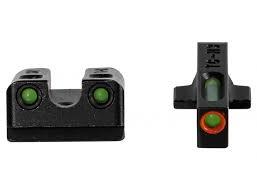

TFX Pro Night Sights for SIG P365 feature green tritium with an orange outline, enhancing quick target acquisition. These sights are specifically designed to improve shooting accuracy in various lighting conditions, making them suitable for both competitive and casual use. Their robust construction ensures they can withstand everyday wear and tear, providing reliability when it matters most. The easy-to-use installation process allows shooters to upgrade their firearms without the need for a gunsmith, making it accessible for all skill levels.
Designed for low-light performance, the TFX Pro Night Sights excel in visibility, allowing shooters to focus on their target with confidence. The polymer construction is lightweight yet durable, ensuring optimal performance without adding unnecessary weight to your firearm. These sights are engineered to provide a tactical edge, enhancing both control and precision during critical shooting scenarios.
Features:
- HIGH-VISIBILITY SIGHTS provide rapid target acquisition in low-light and bright conditions.
- TRITIUM ILLUMINATION ensures you can aim accurately in complete darkness.
- EASY INSTALLATION allows for a hassle-free upgrade to your SIG P365.
- COMPACT DESIGN makes these sights ideal for concealed carry and everyday use.
- ROBUST CONSTRUCTION withstands heavy use and environmental challenges.
- USER-FRIENDLY TEXTURE improves grip for enhanced handling during shooting.
- WATER-RESISTANT ensures reliable performance in various weather conditions.
- CUSTOMIZABLE VISIBILITY with adjustable tritium inserts for personalized shooting needs.
Technical Specifications Table
| Feature | Specification |
|---|---|
| Weight | 0.45 lbs |
| Dimensions | 4.1 x 1.3 x 1.0 inches |
| Material | Polymer and Tritium |
| Color | Black with Orange Outline |
What’s in the Box?
- TFX Pro Night Sights for SIG P365
- Installation Tools
- Instruction Manual
Customer Reviews
"These sights transformed my shooting experience. The visibility is exceptional, especially at night!" - Alex T.
"Installation was straightforward, and the accuracy improved instantly. Highly recommend!" - Sarah L.
FAQ
How do TFX sights perform in low-light conditions? TFX sights utilize tritium illumination, providing a bright sight picture in low-light environments. This feature significantly enhances target acquisition compared to standard sights, making them a reliable choice for tactical situations.
Can I install these sights myself? Yes, the TFX sights come with installation tools and an easy-to-follow manual. Most users can complete the installation without professional assistance, making it an accessible upgrade for all shooters.
How do TFX sights compare to traditional sights? Unlike traditional sights, TFX sights offer superior visibility in varying light conditions due to their tritium technology. This gives shooters a distinct advantage in low-light scenarios and ensures consistent performance regardless of environment.
Similar Models
If you're exploring further upgrades, check out our range of TFX Pro sights for other handgun models, including the TFX Pro Sight Set for Glock and the TFX Pro Night Sights for other SIG models. Each product is designed with the same attention to detail and performance. Explore our complete collection and find the perfect fit for your shooting needs!
You May Also Like
Here’s some of our most similar products people are buying. Click to discover trending style.






